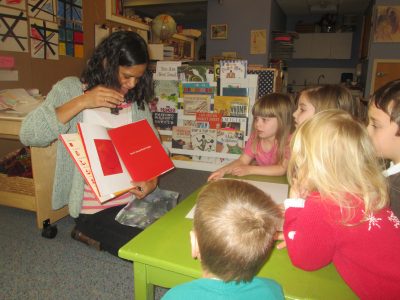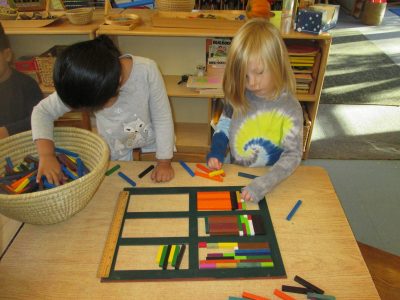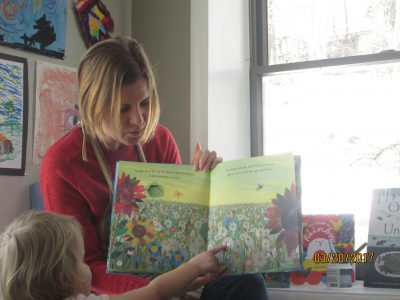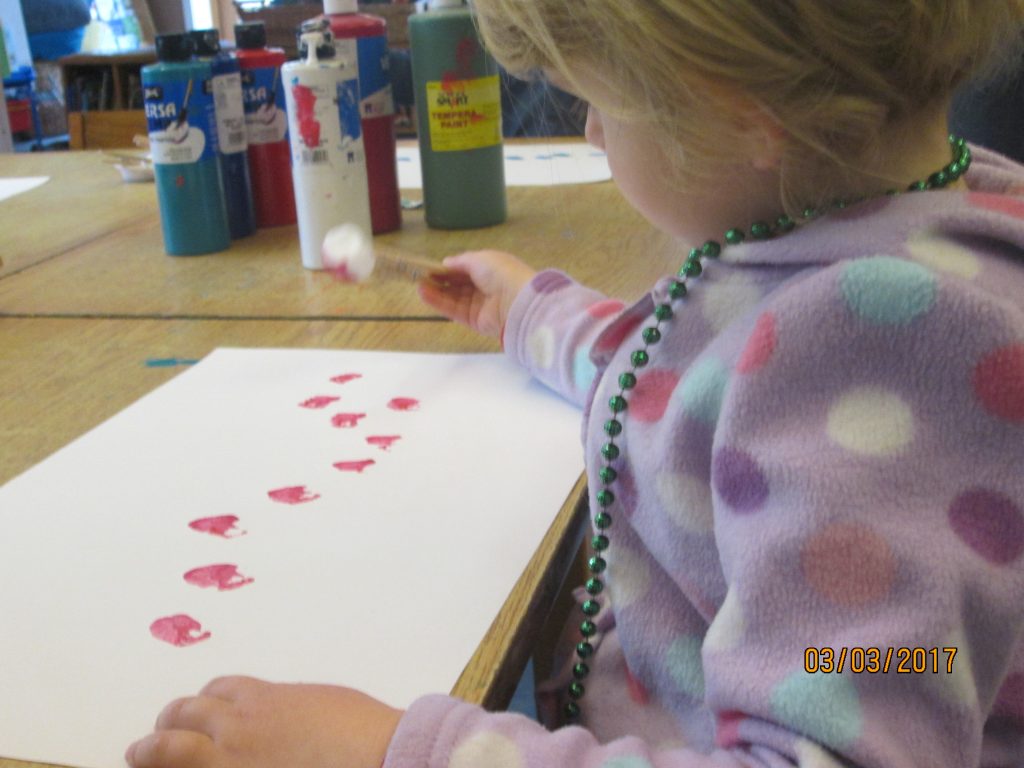Dancing Dots and Tapping Beats: “I Notice a Pattern!”

As soon as our learners stepped outdoors to play this year, they were intrigued by leaves. As they sorted their collection, they found some that were pointy, round, paw-shaped, skinny, and gigantic. They compared the vein pattern on one side and the speckles on the other side. Patterns! Our emergent curriculum leads us far and wide, and the children’s exploration thus far invites us to look at repetition and design of patterns that interconnect within nature, math, sound, movement, and art.
Studying patterns of feathers on the light table revealed characteristics that helped us imagine how birds fly, stay warm, and bathe. We paired this investigation with a read-loud of Feathers Are Not Just for Flying, by Melissa Stewart and Sarah S. Brannen.
What is a quilt? “A blankie.” “They’re made out of fabric.” “One is on my bed.” “It has shapes.” “Triangles.” “There can be lines in a paper quilt.”
The read-aloud of The Quilt, by Ann Jonas, inspired us to create individual quilt squares using six shapes and embellishing the square with “dots doing the polka.” We realized that there can be quilts made from paper, fabric, and other materials. Looking at some nonfiction books about making quilts gave us ideas about how different quilt patterns have unique names, such as “sun and waves” and “wedding rings.” Our learners thought carefully of names during the process of their quilt square design, including “Butterflies” and “Triangles and Squares.” Vocabulary such as vertical, horizontal, and diagonal became meaningful as they arranged the shapes on their quilt squares.
We connected our squares to discover how many pieces make a whole quilt.
A square takes a journey in A Perfect Square, by Michael Hall, and as it breaks into pieces along the way, the possibilities to transform are endless. We began with perfect rectangles that (1) we painted and (2) we cut up into pieces that turned into new stories based on so many ideas.
Some more picture books that demonstrate ways to play with pattern. In Moon Rope: Un Lazo a la Luna, Lois Ehlert uses elements of Peruvian folk art to tell the tale of Mole who is tricked by Fox into trying to climb a grass rope to the moon. “”Rainbow stairs.” “I notice a pattern.” “Up-up-up pattern.” “A pattern. Blue-green-blue-green.” We explored making similar patterns from loose parts during Inquiry.
We engaged with the singing and rhyming patterns of Can’t Scare Me, by Ashley Bryan: Too-de-loo-de-loo-de-loot! Tanto, tanto! I’m wild and I’m free! Grandma’s stories can’t scare me!
Our math circle challenged our learners to play a game with ten frames and patterns on dot cards to develop their subitizing skills, the ability to “instantly see how many.”
Clapping and stomping patterns are Morning Meeting energizers!
We were delighted to welcome two special quiltmakers to our classroom. Sandy shared that “My grandmother made a quilt for me and that’s why I like to quilt.” She described how they can be made from sewn pieces and from an appliqué process. Evan shared his community quilt with us, which was created by Sandy and many other friends.
“How many quilts do you have?” About 30.” “There’s patterns.” “That’s a little quilt.” “I love playing with colors.” Emma’s grandmother showed us a Fields and Furrows quilt, pointed out the hourglass block pattern, and told us an exciting story that corresponded with each meaningful square on Emma’s I Spy story quilt.
Assembling our Velvet Paper Quilt, which is now exhibited in the office. We helped Connie with the installation.
Building our city of shapes after reading City Shapes, by Diana Murray and Bryan Collier.
More ideas about quilts and patterns emerged as we read Rachel Isadora’s Princess and the Pea: “A quilt-shaped mountain!” “I think it’s colorful paper.” “I see a pattern!” To scaffold this experience, we invited our learners to build designs from strips of patterned fabric on heavy stock.
We drummed outdoors with a variety of objects to experiment with sound and pattern, and we made the horizontal and vertical stripes of Gee’s Bend quilts and the triangles of Magna-tiles allow for thoughtful, complex designs.
Then, we welcomed spring with an introduction into beekeeping by Clara’s mom Stephanie, painting the hive with art specialist Nicole. We connected hexagons, trapezoids, and other shapes to make a garden with honeybees, flower blossoms, and, of course, a playground.











































